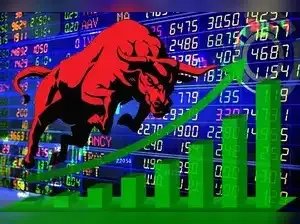The recent turbulent ride in local equities that pushed investors to the edge could spill over to the new financial year as nervous market participants worldwide brace for Donald Trump’s unveiling of a slew of tariffs on April 2.
The current unease over the market outlook aside, money managers and analysts believe India’s stock benchmarks will log gains in the second part of the fiscal year, with a likely rebound in local corporate earnings potentially encouraging foreign investors to return to D-Street. In the financial year that ended March 31, the Sensex and Nifty advanced around 5% each after posting gains of 28% in the previous fiscal. Both the indices, which were on a record-breaking run until the last week of September, gave up most of the gains following seemingly unrelenting sales by foreign institutions.
The sell-off through the second half of the financial year also took a toll on broader market. For the full fiscal year, the Nifty Mid-cap 150 index rose 5.7%, and the Small-cap 250 gained 2.3%.
The second-half losses would have been sharper, but for aggressive purchases from domestic institutions, mainly mutual funds, armed with record monthly flows for most of the financial year, and a 10-day rebound in March. Whether the recovery continues in the new financial year would depend on Trump’s tariff policy, and whether foreign investors’ renewed interest in India continues.
The reciprocal tariffs kick off on April 2.
“What is bogging down investors right now is the uncertainty about foreign flows and Donald Trump's policy on India,” said Nilesh Shah, MD, Kotak Mutual Fund.
Since the sell-off that began late in September last year, foreign investors have dumped shares worth ₹2.81 lakh crore in the secondary market. The pace of their selling slowed down in March as they bought shares worth ₹5,982.01 crore.
“Although foreign investors have bought recently, it’s not clear whether they will continue buying. Similarly, there is a lack of clarity on whether the US policies will be pro-India or not,” said Shah.
It’s not the tariff policy per se that is making investors uneasy. While there is consensus on Wall Street that the tariffs are going to be inflationary, making it tough for the US Federal Reserve to cut interest rates aggressively, It’s the constant flip-flop on the course of action by the Oval Office that has left market participants wondering about the fate of the US and the global economies.
“When the world's biggest consumer of goods is saying that sending your goods to America is a privilege and you should pay for that in form of tariffs, it is only natural for investors to worry about what is in store for the global economy in the near future,” said Ritesh Jain, co-founder, Pinetree Macro. “The end game is clear but nobody knows how the path is laid out, which will keep investors nervous.”
Indian benchmark indices have corrected over 10% from their peak in September, while the Nifty Mid-cap 150 and Small-cap 250 indices tumbled 14.5% and 18%, respectively. Beneath the surface, many stocks are down 30-50% from their highs in 2024. Brokers and analysts said that despite the drop in the prices, there is no big rush to lap up battered stocks in the face of the uncertainty. Investors are mostly looking to preserve their capital.
The uncertainty may not last beyond the next three to six months unless the US economy slips into a recession. That would be a good time for global investors to consider Indian equities again.
“Over the next six months, investors will become numb to the pain and that’s the time the spotlight will be back on India,” said Jain.
The current unease over the market outlook aside, money managers and analysts believe India’s stock benchmarks will log gains in the second part of the fiscal year, with a likely rebound in local corporate earnings potentially encouraging foreign investors to return to D-Street. In the financial year that ended March 31, the Sensex and Nifty advanced around 5% each after posting gains of 28% in the previous fiscal. Both the indices, which were on a record-breaking run until the last week of September, gave up most of the gains following seemingly unrelenting sales by foreign institutions.
The sell-off through the second half of the financial year also took a toll on broader market. For the full fiscal year, the Nifty Mid-cap 150 index rose 5.7%, and the Small-cap 250 gained 2.3%.
The second-half losses would have been sharper, but for aggressive purchases from domestic institutions, mainly mutual funds, armed with record monthly flows for most of the financial year, and a 10-day rebound in March. Whether the recovery continues in the new financial year would depend on Trump’s tariff policy, and whether foreign investors’ renewed interest in India continues.
The reciprocal tariffs kick off on April 2.
“What is bogging down investors right now is the uncertainty about foreign flows and Donald Trump's policy on India,” said Nilesh Shah, MD, Kotak Mutual Fund.
Since the sell-off that began late in September last year, foreign investors have dumped shares worth ₹2.81 lakh crore in the secondary market. The pace of their selling slowed down in March as they bought shares worth ₹5,982.01 crore.
“Although foreign investors have bought recently, it’s not clear whether they will continue buying. Similarly, there is a lack of clarity on whether the US policies will be pro-India or not,” said Shah.
It’s not the tariff policy per se that is making investors uneasy. While there is consensus on Wall Street that the tariffs are going to be inflationary, making it tough for the US Federal Reserve to cut interest rates aggressively, It’s the constant flip-flop on the course of action by the Oval Office that has left market participants wondering about the fate of the US and the global economies.
“When the world's biggest consumer of goods is saying that sending your goods to America is a privilege and you should pay for that in form of tariffs, it is only natural for investors to worry about what is in store for the global economy in the near future,” said Ritesh Jain, co-founder, Pinetree Macro. “The end game is clear but nobody knows how the path is laid out, which will keep investors nervous.”
Indian benchmark indices have corrected over 10% from their peak in September, while the Nifty Mid-cap 150 and Small-cap 250 indices tumbled 14.5% and 18%, respectively. Beneath the surface, many stocks are down 30-50% from their highs in 2024. Brokers and analysts said that despite the drop in the prices, there is no big rush to lap up battered stocks in the face of the uncertainty. Investors are mostly looking to preserve their capital.
The uncertainty may not last beyond the next three to six months unless the US economy slips into a recession. That would be a good time for global investors to consider Indian equities again.
“Over the next six months, investors will become numb to the pain and that’s the time the spotlight will be back on India,” said Jain.








